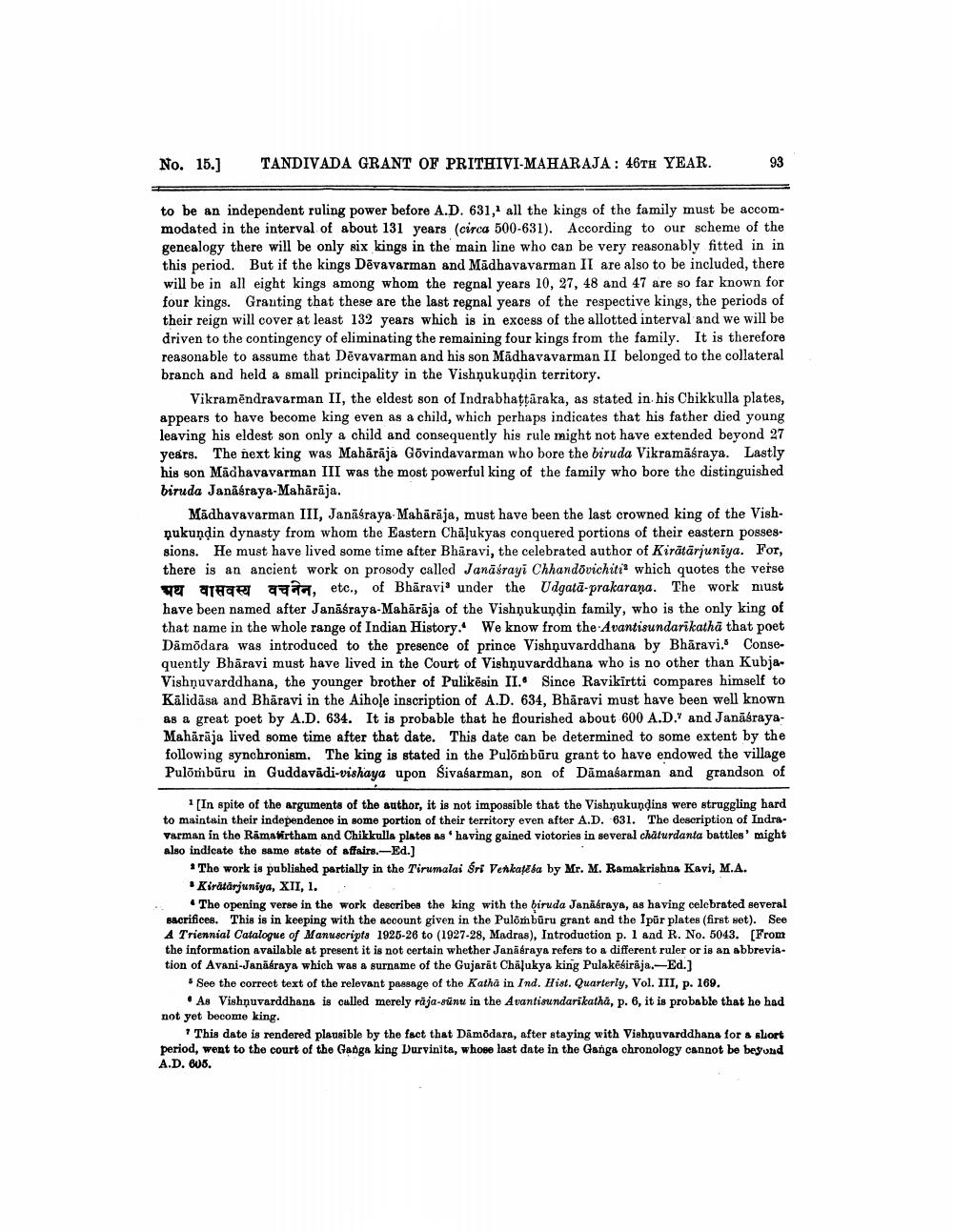________________
No. 15.]
TANDIVADA GRANT OF PRITHIVI-MAHARAJA : 46TH YEAR.
to be an independent ruling power before A.D. 631, all the kings of the family must be accommodated in the interval of about 131 years (circa 500-631). According to our scheme of the genealogy there will be only six kings in the main line who can be very reasonably fitted in in this period. But if the kings Dēvavarman and Mädhavavarman II are also to be included, there will be in all eight kings among whom the regnal years 10, 27, 48 and 47 are so far known for four kings. Granting that these are the last regnal years of the respective kings, the periods of their reign will cover at least 132 years which is in excess of the allotted interval and we will be driven to the contingency of eliminating the remaining four kings from the family. It is therefore reasonable to assume that Dēvavarman and his son Mädhavavarman II belonged to the collateral branch and held a small principality in the Vishņukuņdin territory.
Vikramêndravarman II, the eldest son of Indrabhattāraka, as stated in his Chikkulla plates, appears to have become king even as a child, which perhaps indicates that his father died young leaving his eldest son only a child and consequently his rule might not have extended beyond 27 years. The next king was Mahārāja Govindavarman who bore the biruda Vikramāśraya. Lastly his son Madhavavarman III was the most powerful king of the family who bore the distinguished biruda Janaśraya-Mahārāja.
Mādhavavarman III, Janäsraya Mahārāja, must have been the last crowned king of the Vishpukuņdin dynasty from whom the Eastern Chāļukyas conquered portions of their eastern posses. sions. He must have lived some time after Bhāravi, the celebrated author of Kirātārjuniya. For, there is an ancient work on prosody called Janaśrayi Chhandovichitia which quotes the verse ve arhe a , etc., of Bhāravid under the Udgatā-prakarana. The work must have been named after Janāsraya-Mahārāja of the Vishņukundin family, who is the only king of that name in the whole range of Indian History. We know from the Avantisundarikathā that poet Damodara was introduced to the presence of prince Vishņuvarddhana by Bhäravi. Consequently Bhāravi must have lived in the Court of Vishņuvarddhana who is no other than Kubja Vishsuvarddhana, the younger brother of Pulikēsin II. Since Ravikirtti compares himself to Kálidāsa and Bharavi in the Aihole inscription of A.D. 634, Bhāravi must have been well known as a great poet by A.D. 634. It is probable that he flourished about 600 A.D. and JanāsrayaMahārāja lived some time after that date. This date can be determined to some extent by the following synchronism. The king is stated in the Pulombūru grant to have endowed the village Pulombūru in Guddavādi-vishaya upon Sivasarman, son of Dāmasarman and grandson of
1 [In spite of the arguments of the author, it is not impossible that the Vishnukundins were struggling hard to maintain their independence in some portion of their territory even after A.D. 631. The description of IndraVarman in the Rāmatirtham and Chikkulla plates as having gained viotories in several chaturdanta battles' might also indicate the same state of affairs.-Ed.]
1 The work is published partially in the Tirumalai Sri Venkaltba by Mr. M. Ramakrishna Kavi, M.A. • Kirātārjuniya, XII, 1. .
The opening verse in the work describes the king with the biruda Janásraya, as having celebrated several Bacrifices. This is in keeping with the account given in the Pulombūru grant and the Ipār plates (first set). See A Triennial Catalogue of Manuscripts 1925-26 to (1927-28, Madras), Introduction p. 1 and R. No. 5043. (From the information available at present it is not certain whether Janāóraya refers to a different ruler or is an abbreviation of Avani-Janāáraya which was a surname of the Gujarat Chāļukya king Pulakēsirāja.-Ed.]
5 See the correct text of the relevant passage of the Katha in Ind. Hist. Quarterly, Vol. III, p. 169.
• As Vishņuvarddhana is called merely rāja-sūnu in the Avantisundarikatha, p. 6, it is probable that he had not yet become king.
This date is rendered plausible by the fact that Damodara, after staying with Vishnuvarddhana for & short period, went to the court of the Ganga king Durvinita, whose last date in the Ganga chronology cannot be beyond A.D. 805.




